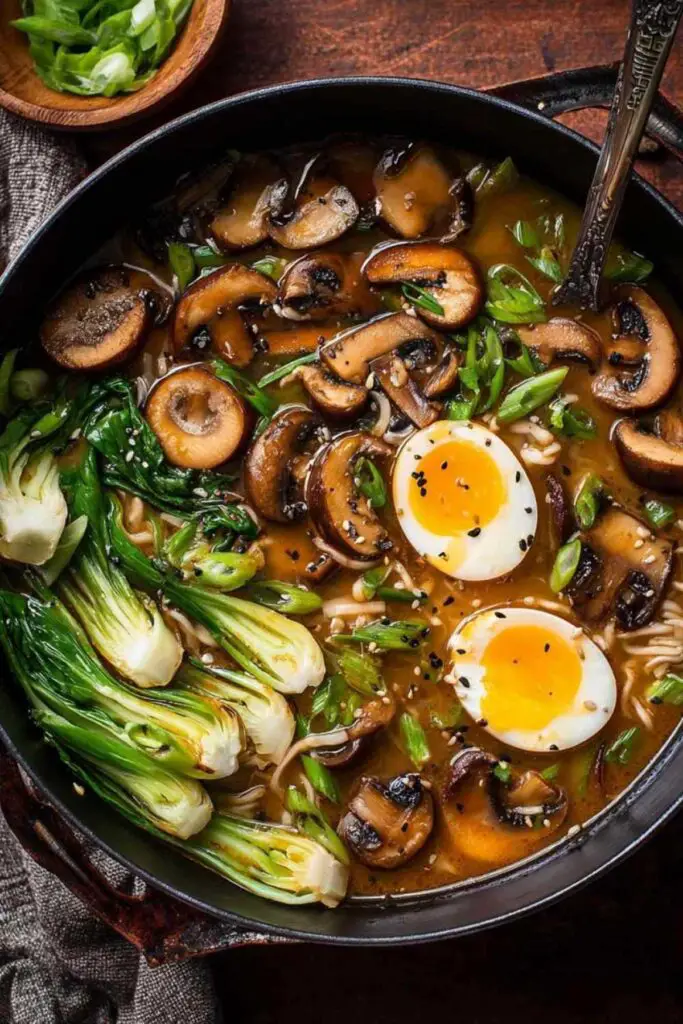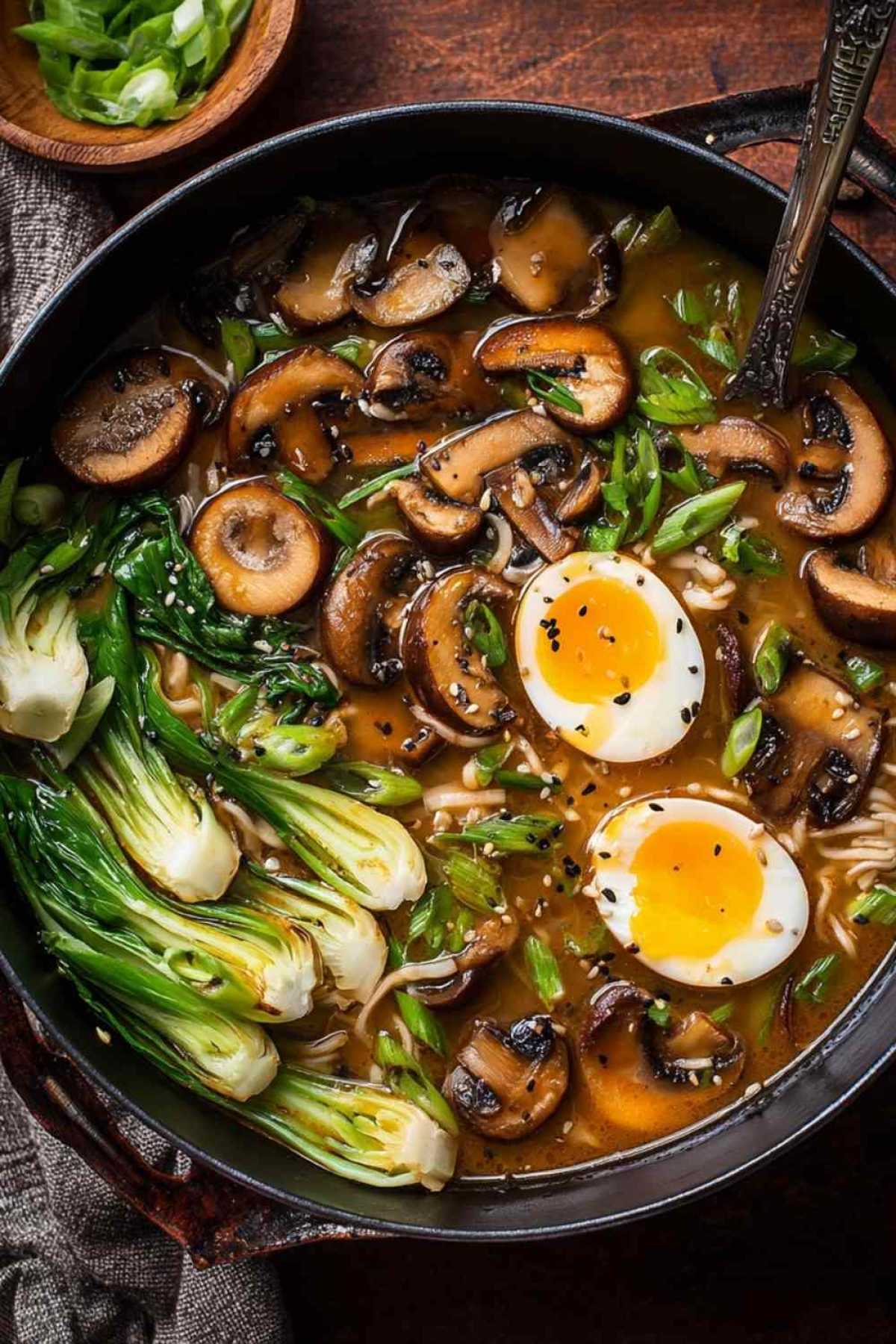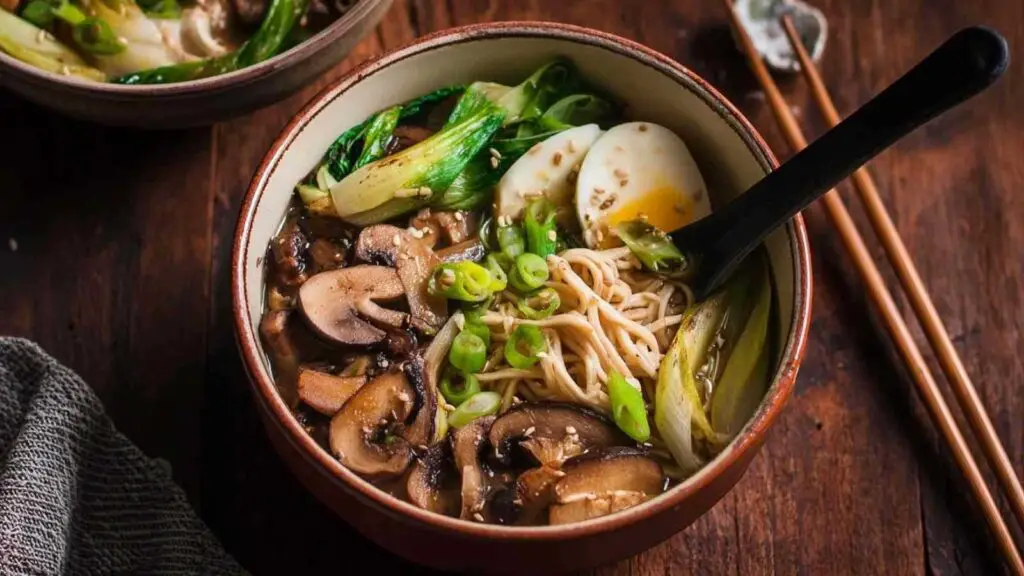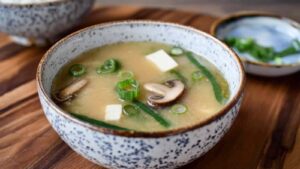Gluten free vegan ramen doesn’t have to mean sacrificing that deep, soul-warming flavor we all crave on chilly evenings. After years of perfecting this recipe in my own kitchen, I’ve discovered the secret to creating restaurant-quality ramen that happens to be both gluten-free and completely plant-based.
There’s something magical about the way miso paste transforms a simple vegetable broth into liquid gold. I remember the first time I tried making ramen from scratch, it was a Sunday afternoon, and I had promised my granddaughter a special lunch. The kitchen filled with the most incredible aroma as the mushrooms simmered with ginger and garlic, creating layers of flavor that reminded me of the cozy noodle shops we’d visit in the city. That bowl brought us together around the kitchen table, slurping noodles and sharing stories, proving that the best meals don’t need fancy ingredients, they just need love and patience. Your kitchen’s about to smell incredible!
What Makes This Gluten Free Vegan Ramen So Special
This miso mushroom ramen has become a weeknight staple in homes across the country, and for good reason. Through countless batches and family taste tests, I’ve refined this gluten free vegan ramen to deliver maximum comfort with minimal fuss.
- Comes together in just 30 minutes on even the busiest evenings
- Uses pantry staples you likely already have in your kitchen
- Delivers consistent, restaurant-quality results every single time
- Adapts easily to dietary preferences and ingredient availability
- Creates that perfect balance of rich broth and tender vegetables
- Provides deeply satisfying umami flavor that rivals traditional ramen shops
The beauty of this recipe lies in its simplicity, no complicated techniques or hard-to-find ingredients, just honest cooking that brings people together.
Understanding Your Ingredients
Gluten-free ramen noodles form the hearty foundation of this bowl, providing that satisfying chew we all love without any wheat. I always choose rice-based noodles for the best texture and flavor absorption.
White miso paste delivers the deep, complex umami flavor that makes this broth so addictive. In my kitchen, I prefer white miso over red because it’s milder and more versatile for everyday cooking.
Dried porcini mushrooms create incredible depth in the broth, releasing earthy flavors that you simply can’t achieve with fresh mushrooms alone. These little flavor powerhouses transform ordinary vegetable stock into something truly special.
Fresh ginger and garlic build the aromatic base that makes your kitchen smell like a professional ramen shop. I’ve found that mincing them finely helps release maximum flavor into the oil.
Baby bella mushrooms add meaty texture and additional umami, perfectly complementing the dried porcini. They hold their shape beautifully and absorb all those wonderful broth flavors.
Baby bok choy provides fresh crunch and beautiful color contrast, plus it cooks quickly so it maintains that perfect tender-crisp texture.
Tamari or soy sauce deepens the salty-savory profile while keeping this recipe gluten-free when you choose tamari. Betty always keeps both on hand for different dietary needs.
Chili oil brings gentle heat and aromatic complexity, though you can easily adjust the amount based on your family’s spice preferences.
How to Make Gluten Free Vegan Ramen
Step 1. I always start by getting the ramen noodles cooking first according to package directions, this way everything comes together perfectly at the end.
Step 2. Heat the coconut oil in your Dutch oven over medium heat, then add the minced garlic, dried porcini mushrooms, and fresh ginger. Betty’s tip: let them sizzle for exactly 3 minutes to release maximum flavor without burning.
Step 3. After years of making this recipe, I’ve learned that whisking the miso paste with a small amount of warm broth before adding it prevents any lumps from forming and ensures even distribution.
Step 4. Add the tamari and chili oil to the aromatics, then gradually pour in the vegetable broth while stirring. Bring to a gentle simmer, never boil miso paste as it can become bitter and lose its beneficial enzymes.
Step 5. Let the broth develop its flavors for 15 minutes at a gentle simmer. During this time, prepare your bok choy by cutting off the bottom and separating the leaves for even cooking.
Step 6. Lower the heat to medium-low and add the bok choy, water chestnuts, fresh mushrooms, and sliced shallots. I’ve found that 5 minutes of gentle simmering keeps the vegetables perfectly tender-crisp while allowing them to absorb the broth flavors.
Step 7. Divide your cooked gluten free vegan ramen noodles between serving bowls, then ladle the aromatic miso broth and vegetables over top.
Step 8. Garnish with sliced green onions and toasted sesame seeds for that authentic finishing touch that makes each bowl Instagram-worthy.

Keeping This Ramen Fresh
Refrigerator Storage: I typically store leftover gluten free vegan ramen in airtight containers for up to 3 days. The flavors actually deepen overnight, making day-two ramen even more delicious. Betty’s storage method works best when you keep the noodles and broth in separate containers to prevent the noodles from getting mushy.
Freezing Guidelines: This broth freezes beautifully for up to 3 months, though I recommend freezing it separately from the noodles. Through trial and error, I learned that cooked ramen noodles don’t freeze well, so it’s better to make fresh noodles when you’re ready to serve.
Reheating Methods: For the best texture, I reheat the broth gently on the stovetop over medium-low heat, stirring occasionally. If you’re using the microwave, heat in 30-second intervals to prevent the miso from separating. Always add fresh noodles when reheating for the perfect bowl every time.
Perfect Partners for Gluten Free Vegan Ramen
Crispy Sesame Tofu Cubed and pan-fried until golden, tofu adds protein and delightful texture contrast to your bowl. The nutty sesame coating complements the miso flavors beautifully.
Asian Cucumber Salad Fresh, tangy cucumber salad provides a cooling contrast to the warm, rich broth. Similar to our Din Tai Fung cucumber salad, the acidity helps cleanse your palate between spoonfuls.
Garlic Roasted Sweet Potatoes Thinly sliced and roasted until caramelized, sweet potatoes add natural sweetness that balances the salty umami flavors perfectly. This side dish has become a family favorite in my kitchen.
Steamed Edamame Simple steamed edamame with sea salt makes an ideal starter, providing protein and that satisfying pop of fresh green flavor.
Quick Pickled Vegetables Quick-pickled radishes or carrots add bright acidity and crunch, following traditional ramen shop accompaniments that cut through rich broths.
Air Fryer Parmesan Zucchini Fries For those wanting a satisfying crunch alongside their soup, these crispy zucchini fries provide the perfect textural contrast while keeping the meal lighter.

Gluten Free Vegan Miso Mushroom Ramen
Ingredients
Equipment
Method
- Prepare ramen noodles according to package instructions. Drain and set aside in bowls, covering to keep warm.
- Heat coconut oil in a Dutch oven over medium heat. Add minced garlic, dried porcini mushrooms, and fresh ginger. Sauté for exactly 3 minutes until fragrant but not browned.
- In a small bowl, whisk miso paste with 1/4 cup warm vegetable broth until smooth to prevent lumps.
- Add tamari and chili oil to the aromatics, then gradually pour in the remaining vegetable broth while stirring. Add the miso mixture and stir to combine.
- Bring to a gentle simmer (not a rolling boil) and cook for 15 minutes. The broth should barely bubble to preserve the miso’s flavor and probiotics.
- Reduce heat to medium-low. Add water chestnuts first, then fresh mushrooms and sliced shallots. Simmer for 3 minutes.
- Add bok choy leaves and simmer for 2 minutes until wilted but still vibrant green and tender-crisp.
- Taste and adjust seasoning with more tamari or chili oil as needed. Ladle the hot miso broth and vegetables over the prepared noodles.
- Garnish immediately with sliced green onions and toasted sesame seeds. Serve while hot for the best experience.
Notes
FAQs
Can I make this ramen oil-free for a lighter version?
I recommend sautéing the aromatics in a splash of vegetable broth instead of oil. Many home cooks find success with this method, though the flavor will be slightly less rich than Betty’s traditional preparation.
What can I substitute for miso paste if I can’t find it?
To maintain that deep umami flavor, try using vegetable bouillon paste or a combination of soy sauce and nutritional yeast. The best approach I’ve tested is using 2 tablespoons tamari plus 1 tablespoon nutritional yeast as a starting point.
How do I prevent the vegetables from getting mushy?
Betty’s solution is to add firmer vegetables like water chestnuts first, followed by the bok choy last. Keep the heat at a gentle simmer and watch your timing carefully, 5 minutes is usually perfect.
Can I make this ramen ahead for meal prep?
I’ve found that storing the components separately works best. Prepare the broth up to 3 days ahead, but cook fresh noodles and quickly blanch fresh vegetables when you’re ready to serve for the best texture.
Is this recipe suitable for children?
Many families love this recipe because you can easily adjust the chili oil to taste. Start with just a few drops for little ones, or skip it entirely and let each person add their preferred level of heat.
What type of gluten-free noodles work best?
The most successful substitutes I’ve tested are rice ramen noodles or brown rice udon. Both hold their texture well and absorb the flavorful broth beautifully without falling apart.
Can I add more vegetables to make it heartier?
Absolutely! This recipe works wonderfully with additions like mushroom varieties, bean sprouts, or thinly sliced carrots. For inspiration on vegetable preparation, check out our grilled vegetable skewers for techniques that work well in ramen too.
How does this compare to other Asian noodle dishes?
While this gluten free vegan ramen focuses on Japanese flavors, you might also enjoy our chicken stir fry with veggies for a different take on Asian noodle dishes. The techniques are similar, but the flavor profiles offer delicious variety.
What other comfort soups pair well with this style of cooking?
If you love the warming comfort of this ramen, you’ll absolutely adore our broccoli cheddar soup for cozy evenings when you want that same soul-warming feeling with different flavors.








